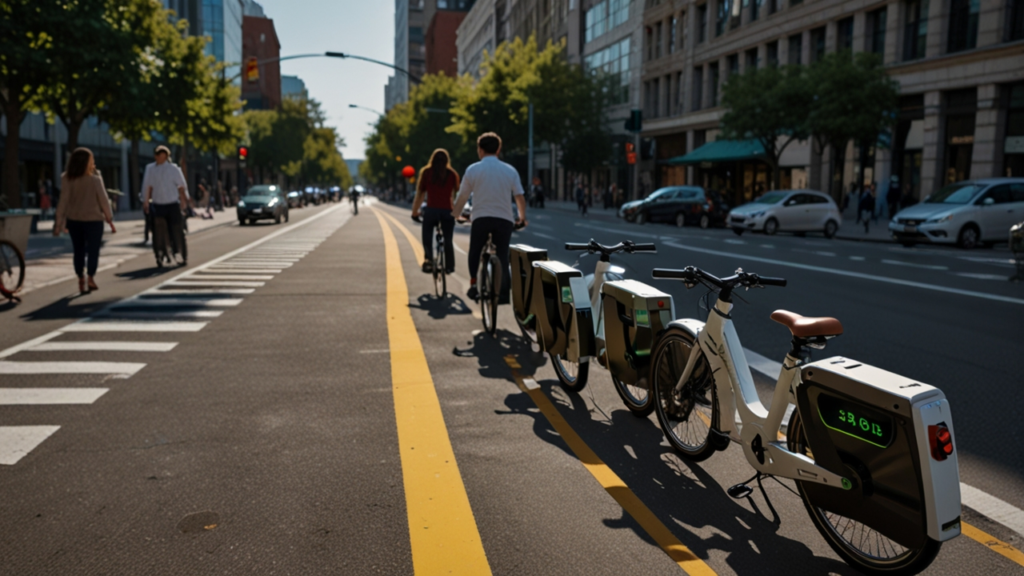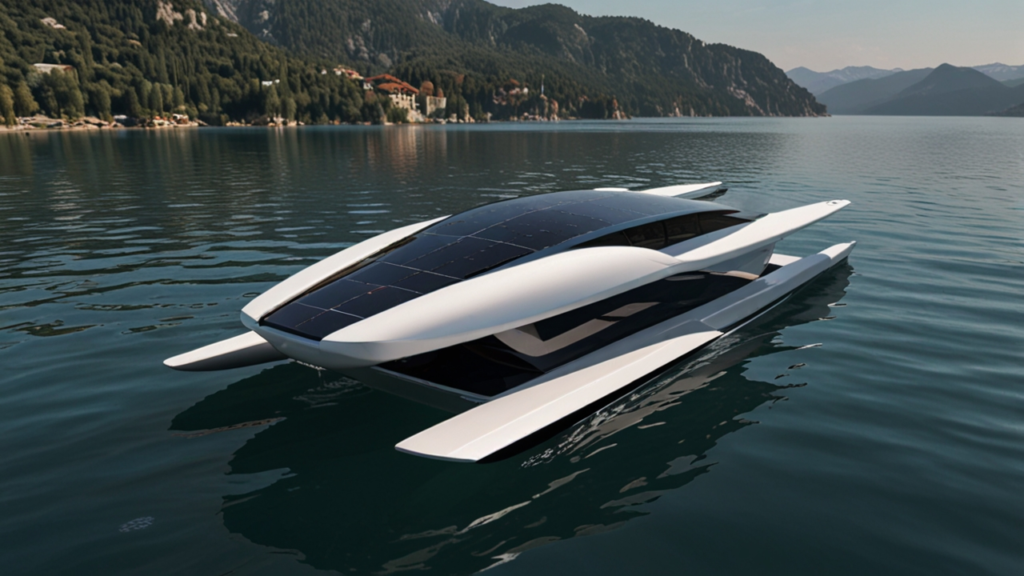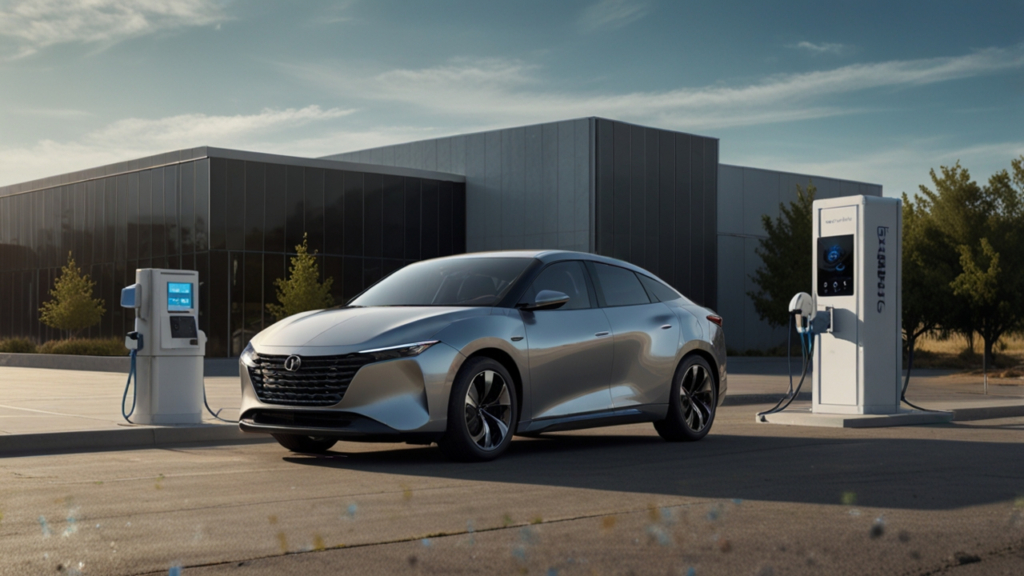Ebikes Revolution 2025
Welcome to our deep dive into the future of rideable mobility. In this post, we explore how Ebikes are reshaping urban landscapes and revolutionizing transportation dynamics around the globe. Designed for a diverse audience, our analysis combines historical breakthroughs, current innovations, and future forecasts—all presented in a friendly, accessible tone.
As you read, you will discover an in-depth look at the evolution of these electric cycles. We explain technical details like battery innovations and pedal assistance in simple language to help you fully understand the disruptive changes underway. Have you ever wondered how decades of innovation culminate in the Ebikes you see today?
Our comprehensive guide also offers real-world case studies and engaging examples to inspire your own journey toward future mobility. So, let’s unravel the story behind Ebikes Revolution 2025. We invite you to join the conversation, share your thoughts, and even comment with your experiences.
Table of Contents
Introduction to Ebikes
Understanding the Concept
Over the years, Ebikes have emerged as a game-changer in the mobility sector. The idea behind these cycles is relatively simple—they are bicycles enhanced with advanced technologies to boost performance through electric power. These cycles are not mere prototypes but fully functional vehicles designed to meet the demands of modern transportation.
In today’s world, Ebikes represent a new era in transportation by offering several benefits such as improved range, user-friendly interfaces, and better efficiency compared to traditional bicycles. A closer look at the design reveals how the integration of precise electronic systems has paved the way for more accessible travel. For more information on historical development, check out the historical overview.
By merging lightweight construction with robust power delivery, manufacturers have created cycles that appeal to commuters, adventurers, and technology enthusiasts alike. Have you experienced riding a cycle that seamlessly fuses the past with modern innovation?
The Role of Advanced Technology
Technological innovation is at the heart of these cycles, making them both efficient and sustainable. Key developments in battery design, including the transition from lead-acid to lithium-ion systems, have significantly impacted performance. You can even read a detailed study on the technological evolution from Industry Wired.
Further, integrated systems for monitoring and diagnostics now allow riders to effortlessly manage their cycles via smartphone applications. This change pushes the boundaries of how traditional cycles perform in the modern era. The simplicity and elegance of transforming everyday cycling into a tech-driven experience cannot be overstated.
Imagine a world where every journey is supported by intuitive technology. What innovations do you think will drive the next phase of cycle evolution? Also, check out Electric Vehicles for related discussions.
Evolution and History of Ebikes
Foundations in the 19th Century
The evolution of Ebikes traces back to the late 1800s. The first patent for a battery-powered cycle, which laid the groundwork for future developments, was filed by Ogden Bolton Jr. on December 31, 1895. Early models, such as the Humber electric tandem bike introduced in France around 1897, showcased the potential of this innovative concept. While these models were heavy and limited by the battery technologies of their time, they signified the birth of electrically assisted cycles.
These pioneering designs, though rudimentary, set the stage for future improvements and sparked a long process of technological refinements. Moving through the ages, crucial breakthroughs were made as researchers experimented with different power sources and design elements. For a comprehensive perspective, you can refer to a rail trails report discussing early innovations.
Even today, the spirit of those early inventors lives on. What lesson can modern design take from the experimental spirit of the 19th century? Have you ever explored the roots of your favorite modern technology?
Resurgence and Modern Breakthroughs
After a long period of dormancy, Ebikes experienced a renaissance in the 1990s. This resurgence was largely driven by advances in battery and motor technology. Japanese companies, notably Yamaha, played a crucial role by introducing pedal assistance systems in 1993 and modern prototypes in 1989. The United States, too, witnessed a shift as mass-market models such as the E-Bike SX emerged towards the end of the 1990s.
In addition, the rapid expansion of Ebikes in Asia, and particularly in China, has significantly impacted urban transportation. With a compound annual growth rate (CAGR) of nearly 10% globally, recent data shows that around 40 million cycles were in use by 2023, projected to rise to 77 million by 2030. This global surge is reflected in regions like Europe and North America, where enhanced infrastructure and supportive policies have accelerated adoption.
What do you think fueled the resurgence of these cycles? How can past lessons guide modern implementations? Also, explore insights from Emerging Transportation Technologies for further context.
How Electric Cycling Enhances Ebikes
Integration of Battery Innovations
The integration of advanced battery systems has notably transformed Ebikes. Modern cycles primarily utilize lithium-ion batteries, offering higher energy density and longer lifespans compared to their predecessors. These improved batteries are not only lighter but also more efficient, reducing charging times and providing extended ranges. Recent developments include the advent of solid-state batteries, such as Yamaha’s 10-minute charging technology that boasts a 120 km range. This breakthrough represents an evolution from earlier battery technologies and sets a new standard in power delivery.
By optimizing battery performance, manufacturers have elevated the reliability of these cycles, making them ideal for daily commuting and longer journeys. This technical evolution reinforces the idea that performance improvements can drive user confidence. For additional technical details, refer to an analysis on Orbea Rise review.
How does improved battery performance shape your travel expectations? Have you tried a cycle equipped with cutting-edge battery technology? Also, learn more about Green Technology in related innovations.
Smart Features and Connectivity Advances
Modern cycles are no longer just mechanically propelled; they also incorporate smart features that offer enhanced connectivity and monitoring. Smartphone integration now allows riders to track diagnostic data, locate their bikes via GPS, and even deploy theft protection mechanisms. These interconnected systems provide real-time insights into performance, battery status, and maintenance needs, simplifying user experience considerably.
Furthermore, advances in self-balancing and collision avoidance are currently in development, driven by both European and Japanese research initiatives. As a result, these cycles are becoming safer and more intuitive to ride. This transformation from mechanical simplicity to smart, integrated systems is a testament to the rapid evolution in cycle design.
Can you imagine a cycle that fully communicates with your digital devices while you ride? What other functionalities would enhance your journey? More details are available at Energy Efficiency discussions.
Pedal Assistance Systems and Their Applications
Innovations in Pedal Assistance
Pedal assistance systems are a critical component of modern cycles, enabling riders to combine manual pedaling with motor support seamlessly. Originally pioneered in Japan during the 1990s, these systems have evolved significantly over the decades. The design concept allows riders to apply power gradually and smoothly, thereby reducing effort while ensuring a natural cycling experience.
Today’s pedal assistance systems come with multiple power modes and sensors that adjust the level of support based on the rider’s input. This technology not only improves efficiency but also extends the range of cycles. Manufacturers have tailored these systems for both urban commuting and outdoor adventures, ensuring that every riding style is accommodated.
What benefits do you see in a system that allows you to control your ride simply by pedaling? Would such a system influence your decision to switch from a traditional cycle? For more insights, visit Future Transport Solutions.
Applications in Diverse Environments
This advanced pedal assistance goes beyond simple support—it facilitates versatile applications across varying terrains and urban settings. For instance, cycles equipped with these systems are now part of integrated bike-share programs in many cities, adapting easily to both short urban trips and longer recreational rides. In Europe, where 35% of urban commuters rely on cycles as their primary mode of transport, pedal assistance has been a key driver of this shift.
Additionally, these systems have empowered adaptive cycling initiatives that cater to riders with physical disabilities, making them more inclusive. By offering precise control over acceleration and power output, pedal assistance enables smoother travel even in crowded city environments. This design innovation continues to inspire new cycles that are tailor-made for multi-purpose usage.
How do you think adaptive pedal systems could transform daily commuting? Have you witnessed their impact in your city? What changes might you suggest for their future development?
Real-World Case Studies of Ebikes
European Success Stories
Europe has emerged as a leader in the adoption of modern cycles. Countries like Germany and the Netherlands have witnessed impressive per-capita usage thanks to strong government incentives and extensive cycling infrastructure. One standout example is the 2025 Orbea Rise e-MTB introduced in Spain. With its lightweight design, high-capacity batteries, and powerful motors, the Orbea Rise represents the pinnacle of European cycle engineering.
Recent statistics reveal that Europe is poised to achieve a market value of €15.6 billion, with over 10 million cycles expected to be sold in 2025. This has been achieved through a concerted effort that includes well-planned urban infrastructure and supportive regulatory policies. Such success stories inspire further research and development in the cycle sector.
What do you believe are the key factors driving Europe’s success in cycle adoption? Can these models serve as frameworks for other regions? Do share your thoughts below.
Impact in Asia and North America
In Asia, particularly in China, the rapid growth in cycle adoption is remarkable. The introduction of strict battery quality standards, enhanced safety education programs, and infrastructural upgrades—such as dedicated charging stations—has delivered substantial safety improvements across millions of cycles. Over three million local users in Nanning, for example, have experienced reduced accident rates due to these comprehensive measures.
Meanwhile, in North America, cycles are evolving through integration with bike-share programs and innovative payment systems. U.S. cities have recorded a 36% higher usage rate for shared cycles compared to conventional bikes, illustrating their growing popularity in the urban transport ecosystem. These case studies collectively highlight regional impacts and the evolving nature of cycle integration worldwide.
What lessons from these regions could be universally applied to further integrate these cycles into city life? Have you experienced these improvements in your community? Let us know your thoughts in the comments.
Urban Mobility in Modern Ebikes Solutions
Integrating Cycles in City Infrastructure
Urban settings have rapidly adopted modern cycle solutions as a part of their public transportation network. Cities in Europe, Asia, and North America are now integrating cycles into transit systems, bike-share networks, and even last-mile delivery programs. These initiatives have made cycles an integral tool in reducing congestion and lowering carbon footprints. Well-planned cycling lanes and dedicated parking zones have further bolstered their prevalence.
Government incentives, alongside smart city platforms, have created an ecosystem that supports these cycles as a key element in urban mobility. The transformation is evident from a 269% increase in cycle sales in the U.S. from 2019 to 2022. Such data underscores the tangible benefits of standardized infrastructure and regulatory alignment across regions.
How might your city further encourage the use of cycles? What urban design elements do you think will be crucial in the future of city transport? Share your ideas with us!
Benefits and Challenges in Implementation
While integrating cycles into urban mobility systems has led to numerous benefits, it also presents several challenges. Issues such as variable regulatory frameworks, fragmented city policies, and safety concerns remain obstacles that need addressing. Cities must adopt harmonized standards for battery safety, rider education, and infrastructure requirements to fully realize the potential of these cycles.
The collaborative efforts of multiple stakeholders have, however, significantly mitigated these challenges over time. Innovative solutions such as dedicated charging hubs and circular economy initiatives for battery recycling are beginning to bridge these regulatory gaps and spur further advancements in cycle adoption.
What challenges do you believe are most pressing in transforming urban mobility? Can you think of innovative solutions that might overcome these hurdles?
Future Trends: Battery Transportation and Beyond
Advancing Battery Transportation Solutions
Looking ahead, the future trends of cycle innovation will be largely defined by advancements in battery transportation. With solid-state batteries now emerging and promising faster charging times along with improved safety, the potential for these cycles to operate efficiently is greater than ever. For instance, Yamaha’s progress with a 10-minute charging battery that offers a 120 km range is a glimpse into what the future may hold.
These technological strides are expected to push the boundaries further, leading to even more reliable and efficient cycle systems that cater to both urban and recreational needs. Integrating battery recycling programs and adopting circular economy models ensure that progress is sustainable and environmentally friendly. For additional data, refer to the strategic predictions on TESWAY EBIKE.
How can emerging battery solutions influence your transportation choices? Would you consider upgrading to a cycle with next-generation battery technology? Your insights are welcome.
Emerging Safety and Connectivity Trends
The future of cycle innovation isn’t limited to just battery advancements. Autonomous safety features, including self-balancing and collision avoidance, are also expected to become mainstream. At the same time, cycles will increasingly integrate advanced connectivity features and real-time diagnostics that simplify the riding experience and enhance safety measures.
Urban integration will further be bolstered as cycles are connected with smart city platforms, easing the coordination of first/last-mile transport solutions. These trends indicate that the evolution of cycles will continue to blend innovative technology with practical, everyday applications. Such measures are essential to overcome previous challenges and push the industry further.
In what ways do you think connectivity improvements could make your daily rides safer and more enjoyable? Could these trends lead to a complete transformation of urban commuting?
Comprehensive Comparison of Case Studies
| Region | Market Size/Adoption | Technology Focus | Regulatory Environment |
|---|---|---|---|
| China | Largest global market | Battery safety, recycling | Strict national standards |
| Europe | €15.6B market, 10M+ sales (2025) | Smart tech, sustainability | Supportive policies, integration |
| North America | Rapid growth, urban focus | Connectivity, bike-share | Evolving, fragmented |
| Japan/S. Korea | Steady growth, innovation | Pedal assistance systems | Quality standards, safety |
| Australia | Niche but growing | Urban mobility, sport | Emerging frameworks |
Design Beyond Boundaries
This section explores creative problem-solving in design without referencing the core mobility trends discussed earlier. It delves into design thinking processes and the role of interdisciplinary collaboration in fostering innovative solutions. The methodology involves questioning established norms, encouraging unconventional ideas, and blending art with engineering to solve complex challenges.
Many design experts suggest that the foundation of creative problem-solving lies in the ability to observe nature and adapt its solutions to human challenges. By engaging in thoughtful brainstorming sessions and iterative testing, teams can innovate in ways that transcend conventional expectations. Creative methodologies such as rapid prototyping and user feedback loops ensure that design remains agile and responsive.
The process of rethinking problem spaces encourages designers to explore new materials, adopt sustainability measures, and integrate technology in unforeseen ways. These practices lead to breakthroughs that not only solve specific challenges but also pave the way for a more holistic approach to design and innovation.
In the end, the art of creative problem-solving is a dynamic journey. It calls for a willingness to take risks, an openness to diverse perspectives, and a continuous commitment to learning. What innovative project has inspired you recently, and how do you integrate design thinking into your everyday challenges?
This reflection on design encourages us to think outside the box. It reminds us that every creative solution contributes to a larger tapestry of progress—a powerful message as we move forward.
FAQ
What are Ebikes?
Ebikes are technologically enhanced cycles that combine traditional pedaling with electric power. They are widely used for daily commuting, recreational rides, and urban mobility solutions.
How did Ebikes evolve over time?
Their evolution began in the 19th century with early prototypes and experienced a resurgence in the 1990s driven by advancements in battery and motor technology.
What role does battery innovation play in Ebikes?
Battery innovation is crucial as it directly impacts the cycle’s range, efficiency, and overall performance, moving from lead-acid to lithium-ion and emerging solid-state technologies.
How do pedal assistance systems work?
These systems sense the rider’s input and provide a proportional motor boost, thereby enhancing performance without compromising the natural feel of pedaling.
How are urban mobility and cycle integration evolving?
Cities worldwide are integrating cycles into their public transport networks through bike-share schemes, dedicated infrastructure, and supportive policies to reduce congestion and emissions.
Conclusion
In conclusion, Ebikes Revolution 2025 encapsulates the incredible journey from historical prototypes to modern rideable solutions. With continual innovation in battery transportation, pedal assistance, and smart connectivity, these cycles are transforming urban mobility around the world. Every section of this post highlights breakthroughs, statistics, and case studies that demonstrate how each technological evolution has contributed to making cycles an essential part of modern life.
Our analysis shows that robust infrastructure, government incentives, and cutting-edge technological advancements have created an ecosystem where cycles can thrive. If you are inspired by these trends or if you have experienced similar innovations firsthand, please share your thoughts with us.
For more information, feel free to visit our Future Mobility page, or if you have any questions, do not hesitate to Contact us.
Have you experienced the transformative impact of these cycles in your area? What innovations do you expect to see in the coming years? Your insights are essential for shaping the future of transportation.



